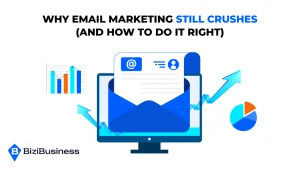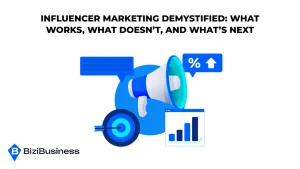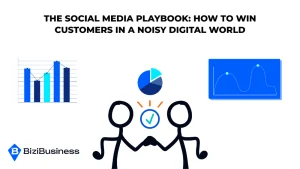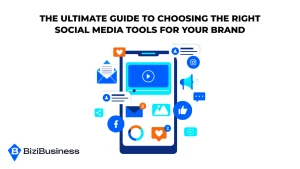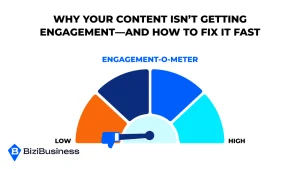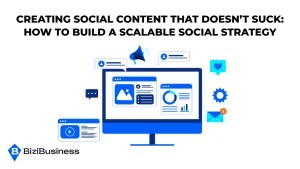BiziTopics
Email Marketing, Mastered: A Step-by-Step Strategy Framework
BiziBusiness
Aug 12, 2025
11 min read
If you’re still “winging it” with your email marketing—writing campaigns week to week, chasing clicks without a plan—it’s time to rethink your approach. Because guesswork doesn’t scale, and inboxes are too crowded for vague tactics.
Email marketing remains one of the highest-ROI cross-channel integration in digital marketing, delivering up to 4400% return for those who use it wisely. But that ROI isn’t magic—it’s math, multiplied by strategy.
What separates top-performing brands from everyone else? A repeatable framework that turns email from an afterthought into a revenue-driving machine.
This article gives you that framework. A step-by-step strategy designed to help you move from chaos to clarity—so every send has a purpose, every subscriber has a path, and every campaign has a measurable impact.
Step 1: Define Clear Goals Before You Write A Word
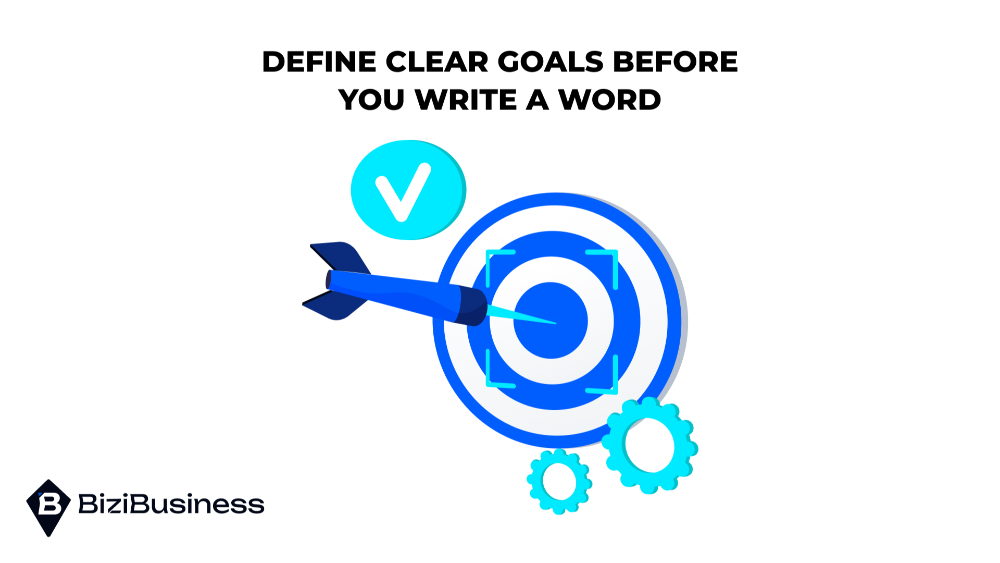
Great email marketing doesn’t start with writing—it starts with clarity. If you don’t know the goal of your campaign, no amount of clever copy or polished design will make it work.
Before drafting subject lines or loading templates, ask: What is this email meant to achieve? Are you trying to grow your list, convert leads, retain customers, or something else entirely?
Know Your Email Objective
Most campaigns fall into one of three categories:
- List building: Attract new, qualified subscribers (lead magnets, landing pages)
- Conversion: Turn subscribers into buyers (promotions, sales, launches)
- Retention: Keep customers engaged and loyal (onboarding, education, loyalty)
Set SMART Email Goals
Your goals should be:
- Specific: “Increase click-through rate on our product promo emails”
- Measurable: “Grow list by 2,000 qualified leads in Q3”
- Achievable: “Re-engage 15% of dormant subscribers in 60 days”
- Relevant: “Drive demo requests from mid-funnel leads”
- Time-bound: “Boost upsells via post-purchase series over next 4 weeks”
Align KPIs with Business Impact
Don’t stop at opens and clicks. Map your goals to business results:
- For list-building: Track cost per subscriber, lead source performance
- For conversions: Focus on revenue per email, sales conversion rate
- For retention: Watch churn rate, LTV, and engagement over time
When your email campaigns have a defined purpose—and measurable targets—you stop guessing and start optimizing with precision.
Step 2: Know Your Audience Better Than Your Competition
Every inbox is a battlefield—and the brands that win are the ones who understand their audience better than anyone else. Generic emails don’t convert. But emails that speak directly to your reader’s pain points, objections, and desires? Those get opened, clicked, and acted on.
That starts with knowing who you’re writing to—not just demographically, but psychographically.
Build Real Buyer Personas
A persona isn’t just a job title. It’s a profile built around what your ideal customer:
- Fears (pain points)
- Wants (motivators and goals)
- Questions (objections or hesitations)
- Values (buying triggers)
Whether you’re selling to busy founders, overwhelmed marketers, or tech-savvy DIYers, you need to tailor your message to their internal dialogue.
Segment Intelligently
One-size-fits-all doesn’t work. Segment your list based on:
- Behavior: click history, engagement, product views
- Lifecycle stage: new subscriber, lead, first-time buyer, repeat customer
- Product interest or use case: based on quiz data, form responses, or past purchases
Even basic segmentation can double engagement rates—because it delivers content that actually feels personal.
Lead With Empathy, Not Just Offers
Great email copy starts with empathy. When you can describe your reader’s problem better than they can, you instantly earn trust.
Instead of leading with features or discounts, try:
- “Feeling overwhelmed by [pain]?”
- “Still unsure if [solution] is right for you?”
- “Here’s how we helped [persona] overcome [problem]—without burning out.”
Because when your email design sounds like it was written for them—not just to them—it breaks through the noise.
Step 3: Craft A Value-First Content Plan

Email marketing isn’t just about what you send—it’s about when, why, and how you deliver value. If your emails are purely promotional, you’ll train subscribers to ignore you—or worse, unsubscribe. But if every message helps them learn, solve, or grow, you earn their attention and their business.
To win long-term, build a content plan that leads with value and closes with confidence.
Balance Education, Entertainment, and Promotion
The best-performing email calendars follow a rhythm. Think:
- Educate: Teach something useful or practical
- Entertain: Share personality, story, or behind-the-scenes content
- Promote: Invite the subscriber to take a meaningful next step
Aim for an 80/20 split: 80% value, 20% sell. That way, when you do make an ask, it feels earned—not intrusive.
The Four Core Email Pillars
- Welcome Series: Set expectations, share your story, and preview your value
- Newsletters: Curated insights, updates, or thought leadership to stay top of mind
- Nurture Sequences: Targeted flows based on interest, behavior, or funnel stage
- Promos & Launches: Product pushes, special offers, or time-sensitive campaigns
Each pillar plays a role in your subscriber journey—from stranger to loyal customer.
Trust Comes First, Sales Follow
Before you pitch anything, prove your credibility. Offer helpful insights, relevant resources, or honest stories. When you give value freely, subscribers are far more likely to pay attention when it counts.
Think of every email as a trust deposit. Over time, those deposits compound into engagement, loyalty, and high-LTV customers.
Step 4: Map the Email Journey with Automation
Email marketing becomes a true growth engine when it’s always working—even when you’re not. That’s the power of automation: delivering the right message to the right person at the right time, based on where they are in their journey.
Done right, automation & workflows turns your email program into a 24/7 conversion system.
Set Up Your Core Automated Flows
Start with the essential sequences every business should have:
- Welcome Flow: Greet new subscribers, deliver your lead magnet, introduce your brand
- Abandoned Cart Series: Recover lost sales with reminders, social proof, or time-limited incentives
- Re-engagement Campaign: Win back inactive subscribers with reintroductions or exclusive offers
- Upsell/Cross-Sell Flow: Recommend complementary products post-purchase or based on browsing behavior
- Post-Purchase Nurture: Thank buyers, set usage expectations, and prime for repeat business or reviews
Each flow automates part of the customer lifecycle—building trust, saving time, and boosting ROI.
Use Behavior Triggers, Not Just Timers
The best automations don’t just send emails on a schedule—they respond to behavior.
Trigger emails when someone:
- Clicks on a key link
- Views a product multiple times
- Downloads a resource
- Becomes inactive for X days
- Completes one sequence and enters another
This level of targeting makes emails feel personal—even when they’re automated.
Choose the Right Platform for Your Stage
Not all ESPs (email service providers) are created equal. Choose based on your list size, team, and tech stack:
- Solo/Small Biz: MailerLite, ConvertKit, Flodesk
- Growth-Stage Teams: ActiveCampaign, Klaviyo, Moosend
- Enterprise/CRM-Integrated: HubSpot, Salesforce Marketing Cloud, Iterable
Look for tools and platforms with visual automation builders, native integrations, and behavior tracking—not just batch-and-blast features.
Step 5: Design For Deliverability And Engagement
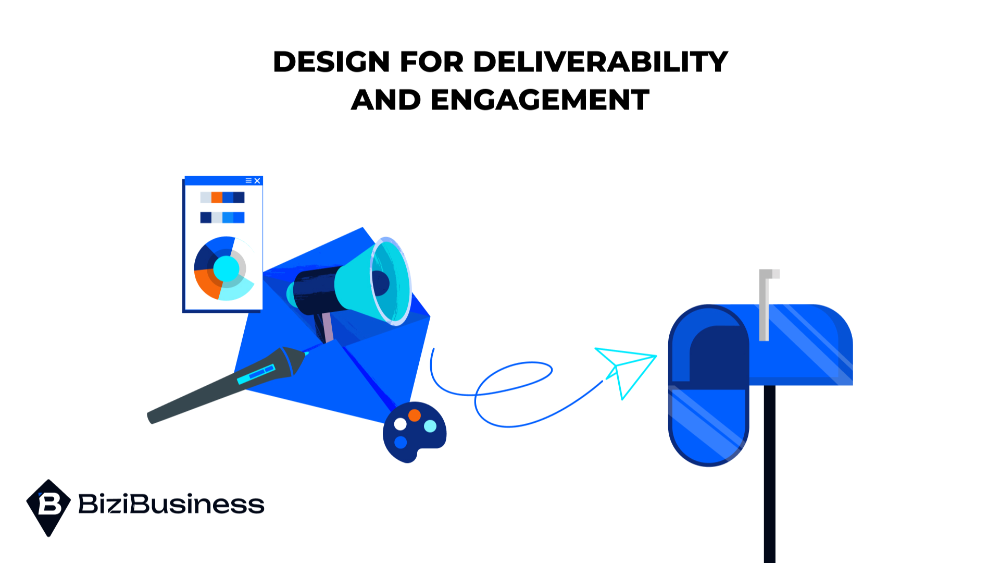
Even the best strategy fails if your emails never make it to the inbox—or get deleted without being read. That’s why smart design goes beyond visuals. It starts with getting delivered, continues with getting opened, and ends with getting clicked.
From subject line to CTA, your email needs to be engineered for performance.
Nail the First Impression: Subject Line, Sender Name, Preview Text
These three elements determine whether your email gets opened—or ignored.
- Subject Line: Keep it short (40–60 characters), specific, and curiosity-driven. Avoid ALL CAPS or clickbait.
- Sender Name: Use a recognizable name. “Jess from [Brand]” often beats “Marketing Team.”
- Preview Text: Use this real estate to expand your hook or clarify the value—not repeat the subject line.
Think of this trio as your email’s elevator pitch.
Build for the Thumb, Not the Desktop
Most email opens happen on mobile. Your layout should be:
- Scannable: Use headers, bullet points, and short paragraphs
- CTA-focused: Make your call-to-action buttons bold, clear, and above the fold
- Accessible: Use readable fonts, strong contrast, and alt text for images
- Lightweight: Limit heavy images or fancy code that may get clipped or blocked
A clean design that loads fast wins every time.
Stay Out of the Spam Folder
Deliverability isn’t luck. It’s a mix of technical hygiene and content best practices.
Technical:
- Authenticate your domain with SPF, DKIM, and DMARC
- Warm up your domain if it’s new
- Use a clean sending IP and monitor bounce/complaint rates
Content:
- Avoid spammy words like “FREE!!!” or “Act now!!!”
- Don’t overdo links, images, or attachments
- Always include a clear unsubscribe option and sender address
The goal? Look like a trusted sender and act like one too.
Step 6: Test Relentlessly
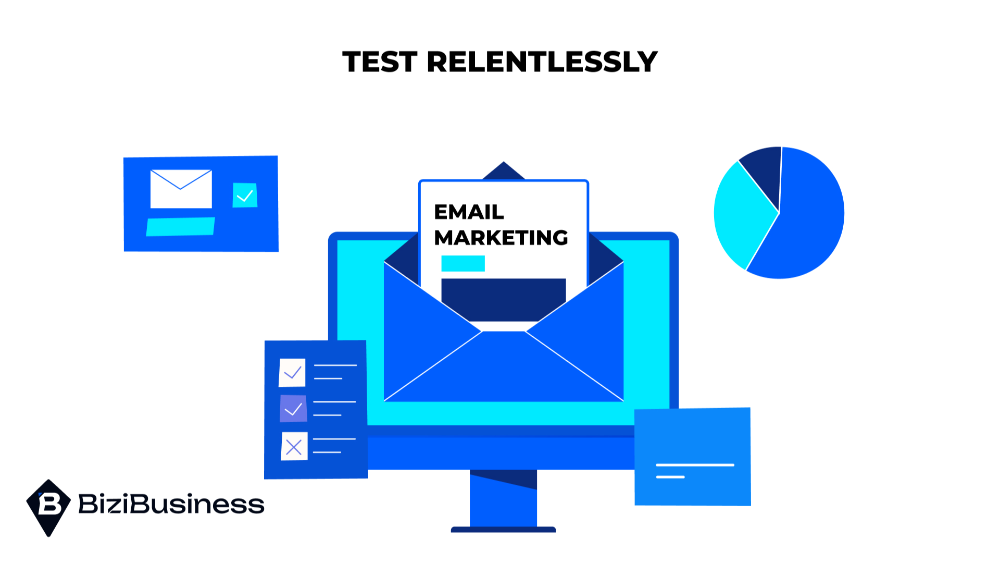
Great email marketing isn’t about guessing. It’s about testing and optimization, tracking, and tuning your way to better performance.
That’s why the best email marketers think like scientists. They don’t assume. They experiment. They don’t chase vanity analytics and metrics, they focus on what actually drives ROI.
If you want to improve results, testing isn’t optional, it’s the engine of optimization.
Start with Smart A/B Test Ideas
You don’t need a data science team to start testing. Begin with high-impact, low-effort variations like:
- Subject Lines: Curiosity vs. clarity, short vs. long, personalized vs. general
- CTA Placement/Language: Top vs. bottom, “Buy Now” vs. “Get the Guide”
- Send Times: Morning vs. afternoon, weekday vs. weekend
- Design Layouts: Button colors, image vs. no image, plain text vs. styled
Test one element at a time for clean results—and track over at least 1,000+ sends for reliability.
Track the Metrics That Actually Matter
It’s easy to get distracted by open rates—but in today’s privacy-first world, they’re increasingly unreliable. Focus on:
- Click-Through Rate (CTR): Who engaged with your content
- Click-to-Open Rate (CTOR): How compelling your content is post-open
- Conversion Rate: Who took your intended action
- Revenue per Email (RPE): How profitable your email really is
If your goal is sales, then dollars, not opens, should be your north star.
Run a Lightweight Experiment Calendar
Don’t let tests get lost in the shuffle. Set up a simple calendar:
- One test per major campaign
- Document your hypothesis, variables, and results
- Review findings monthly, and bake learnings into future sends
This turns testing into a habit—not a hassle. And over time, the insights compound into serious gains.
Step 7: Refine, Re-Engage And Recycle Content
Email strategy isn’t “set it and forget it.” The brands that win long-term aren’t just consistent—they’re iterative. They analyze what’s working, fix what’s not, and scale what performs.
This final step is about squeezing more ROI from the list, content, and effort you already have.
Double Down on What’s Working
You already have winning content—it’s hiding in your metrics. Look at your:
- Top-performing subject lines — reuse or remix the angles
- Best CTR emails — pull insights into future copy/layout
- Highest revenue flows — build complementary sequences or campaigns around them
Success leaves clues. Lean into your best performers instead of constantly reinventing.
Clean Your List. Strategically
Unengaged subscribers hurt your deliverability, drag down metrics, and cost money. But aggressive pruning can stall growth if not done right.
- Run re-engagement sequences every 60–90 days
- Give clear choices: “Still want these tips? Click here.”
- Suppress contacts who don’t engage after multiple nudges
- Segment non-engagers for light-touch campaigns instead of a hard cutoff
Clean lists don’t mean small lists. They mean high-impact ones.
Repurpose Content Into New Sequences
Your blog posts, webinars, and case studies aren’t just one-time assets—they’re email goldmines.
Turn existing content into:
- Educational nurture flows
- Launch warm-ups
- Evergreen drip campaigns
- Lead magnet follow-ups
You already have the insights. Use email to extend their reach—and multiply their value.
Final Word: Mastery Is A Process, Not A One-Off Campaign
Email marketing mastery doesn’t happen overnight—and it definitely doesn’t happen by accident. It’s the result of clear goals, deep audience insight, intentional planning, and a willingness to test, refine, and evolve.
Let’s recap the 7-step framework:
- Define Clear Goals — Know the outcome before you write a word.
- Understand Your Audience — Segment, empathize, and speak their language.
- Build a Value-First Content Plan — Lead with usefulness, not just offers.
- Map the Email Journey with Automation — Guide subscribers from opt-in to conversion.
- Design for Deliverability and Engagement — Get opened, read, and clicked.
- Test Relentlessly — Let data, not guesswork, drive your decisions.
- Refine, Re-Engage, Recycle — Scale what works and sunset what doesn’t.
Use this framework to audit your current email marketing, fix what’s broken, and finally build the system your business needs to grow on autopilot.
Subscribe to Newsletter
Unlock your creativity and stay up to date on marketing tips
